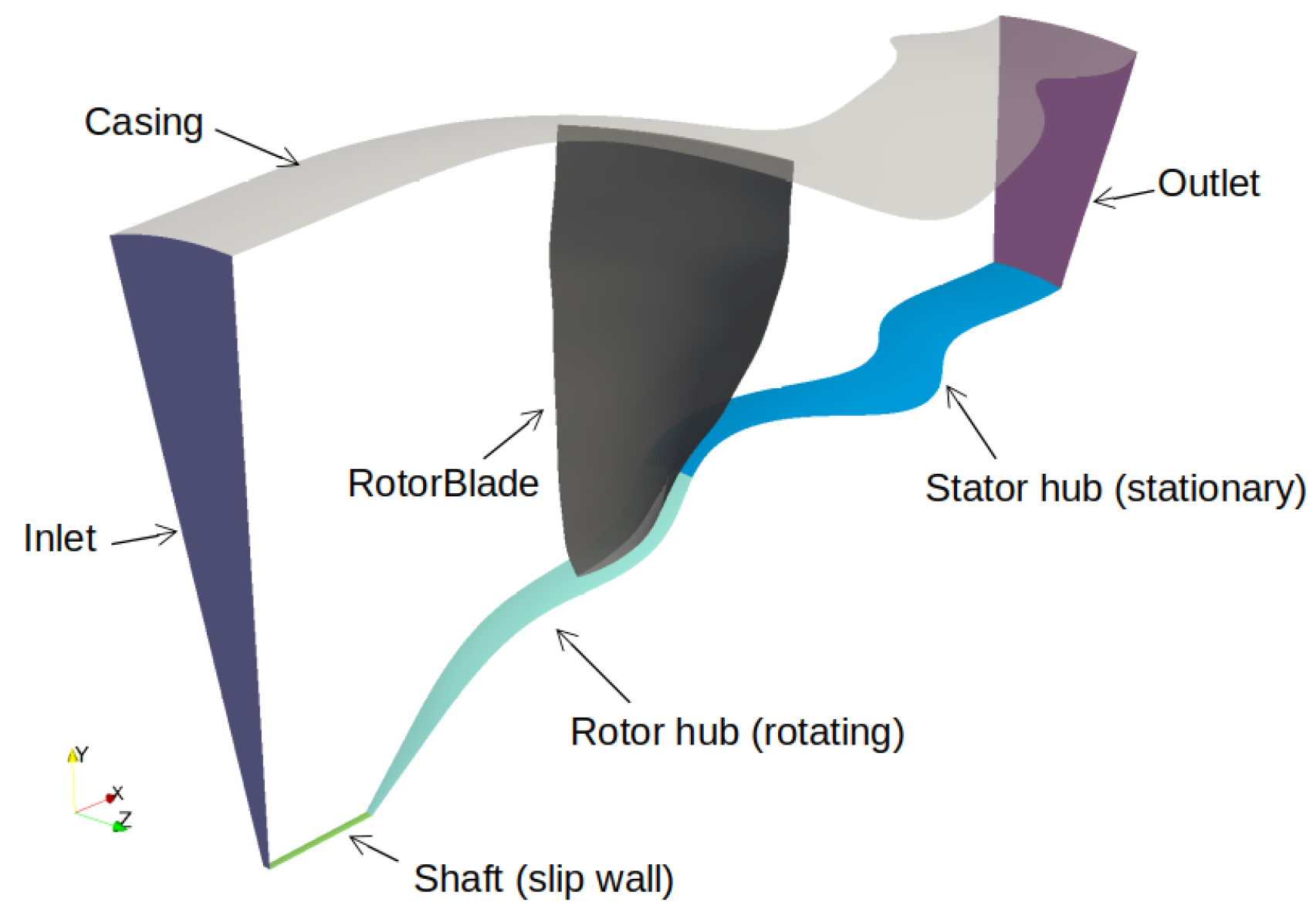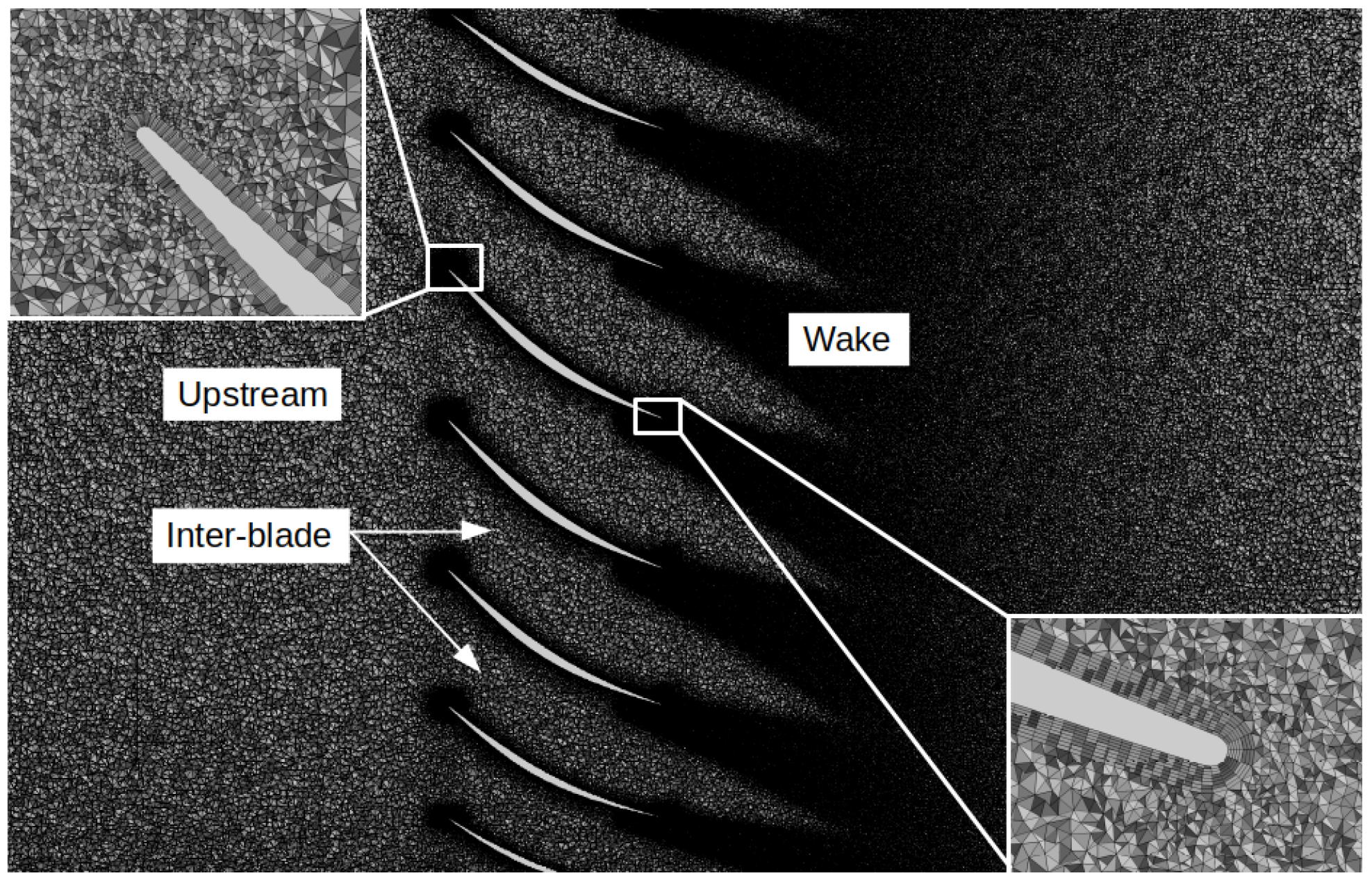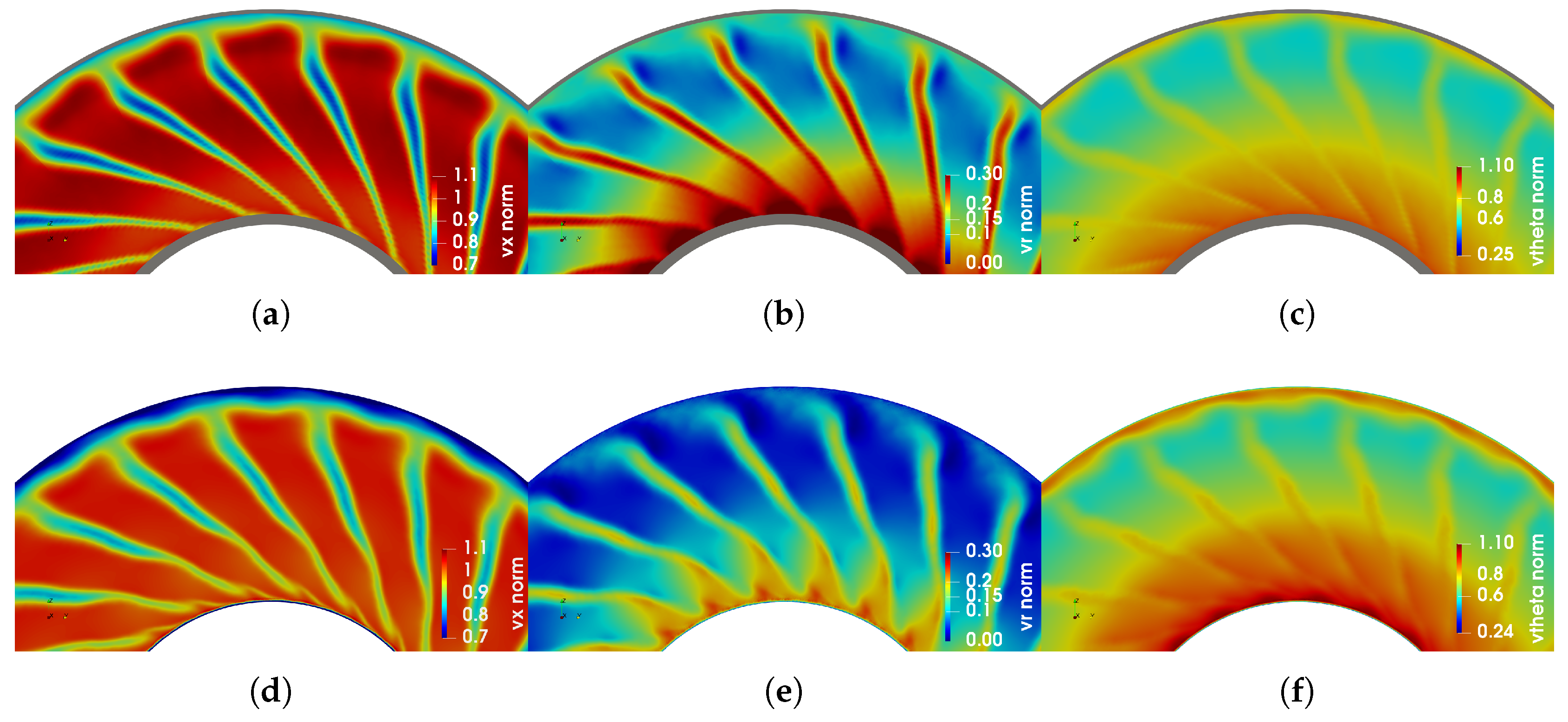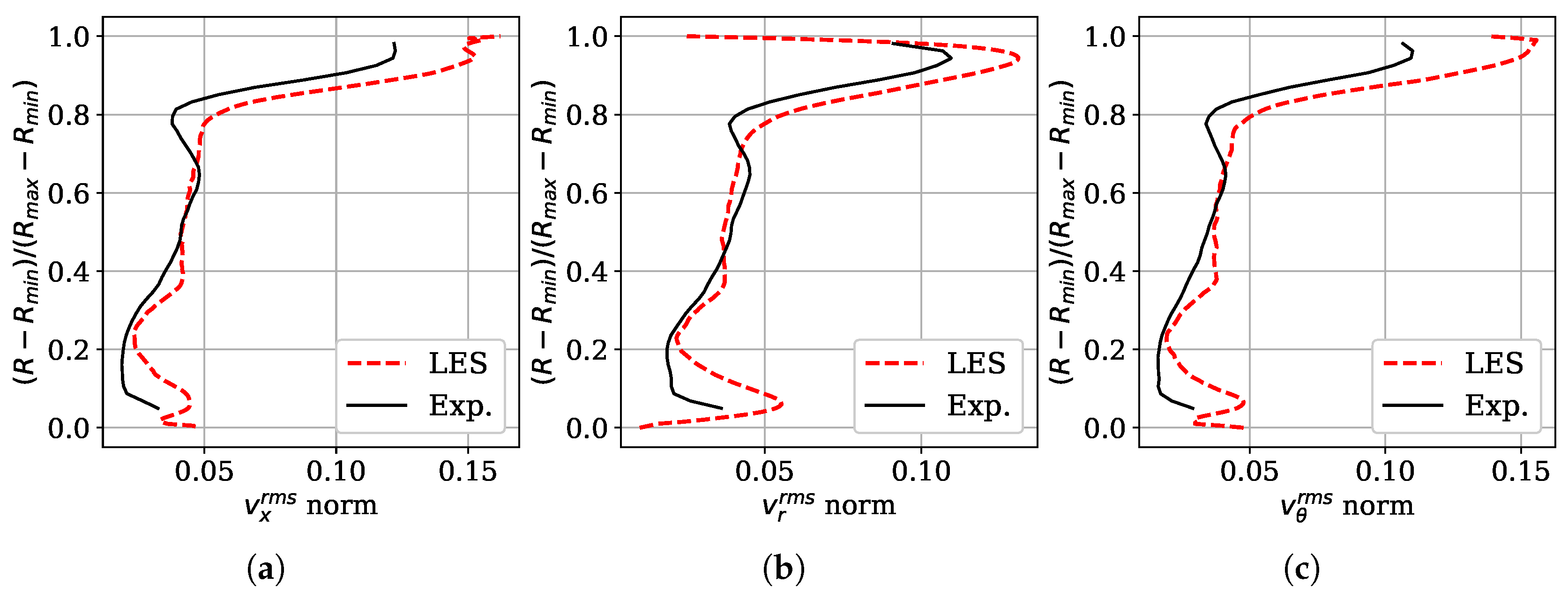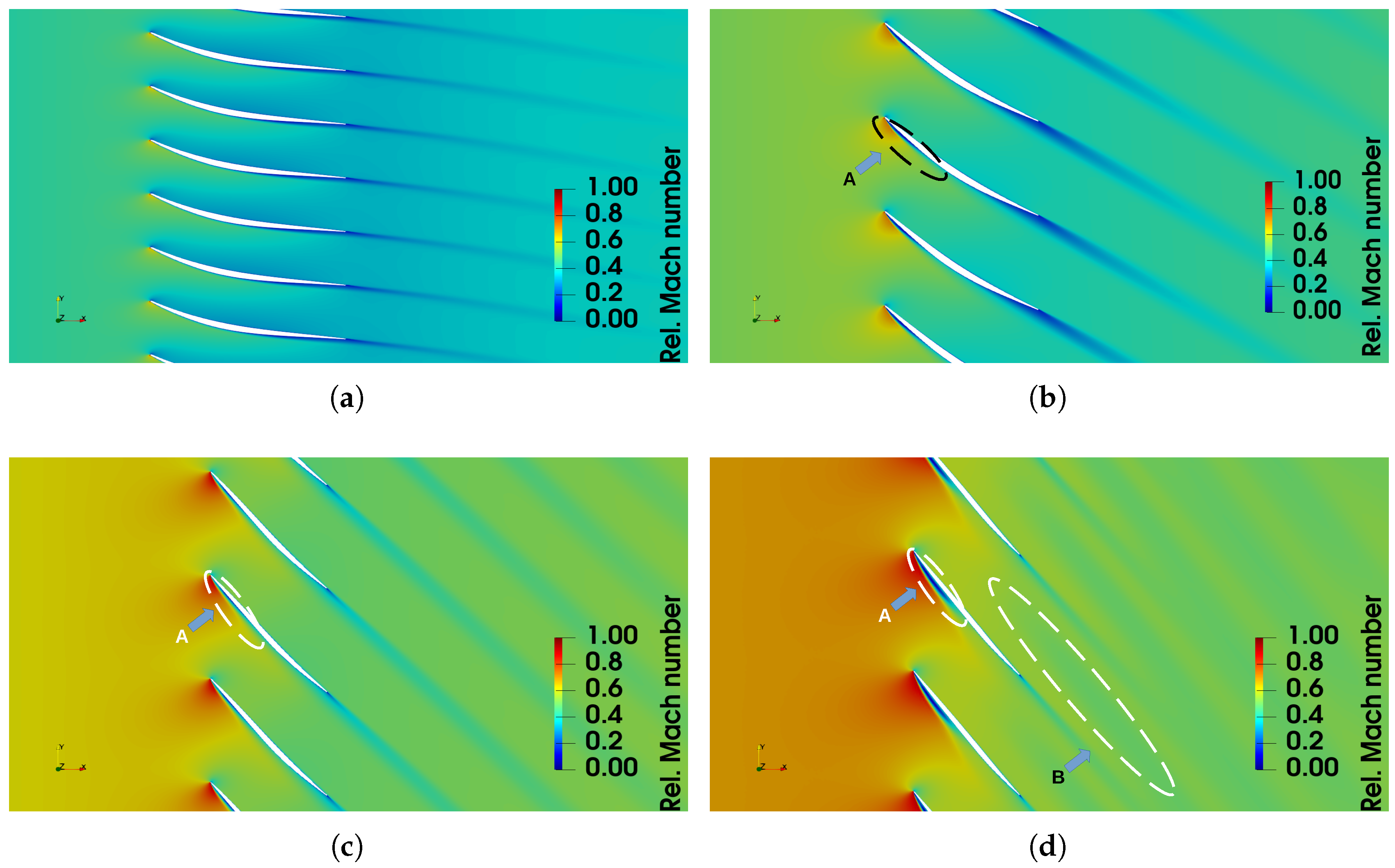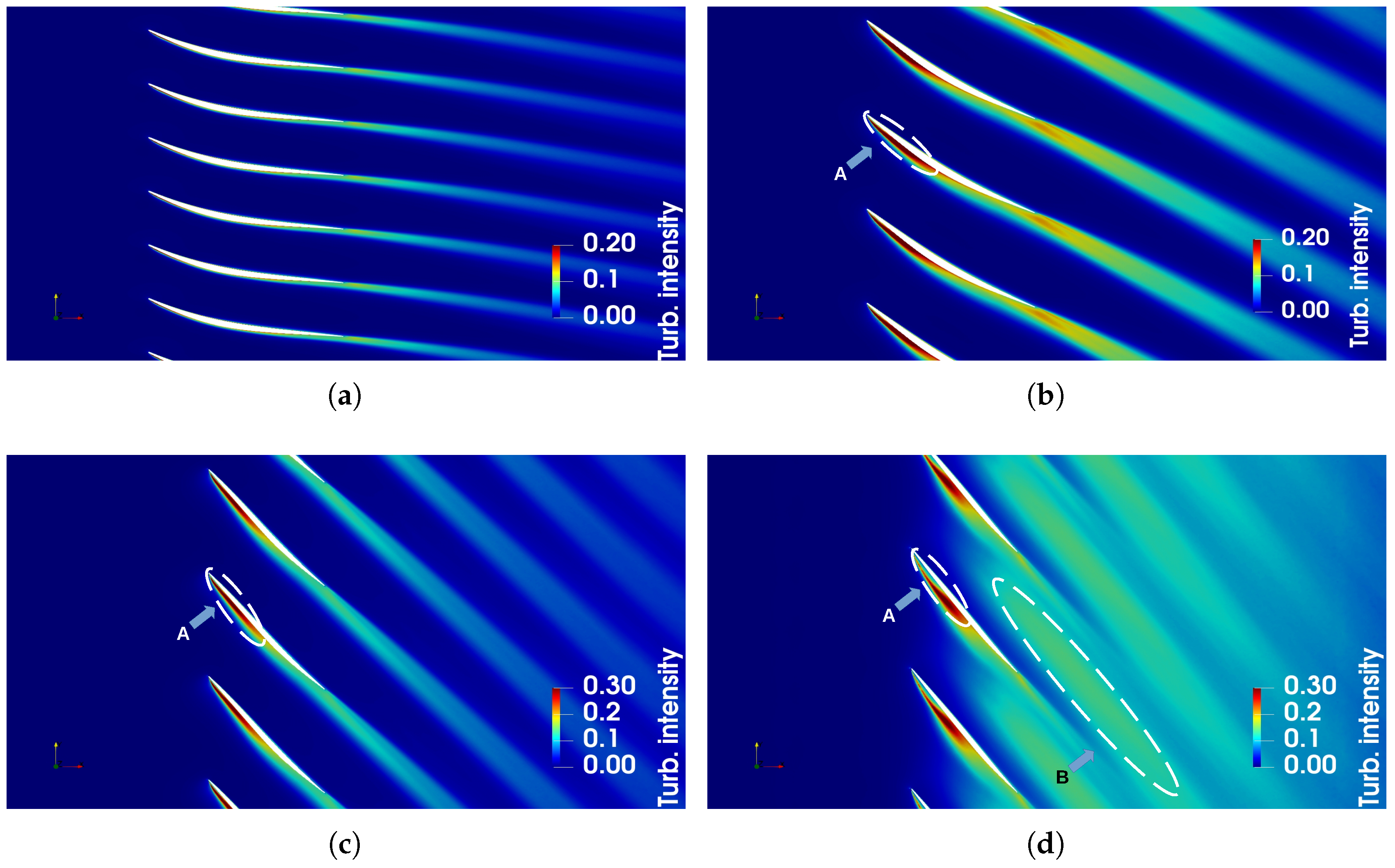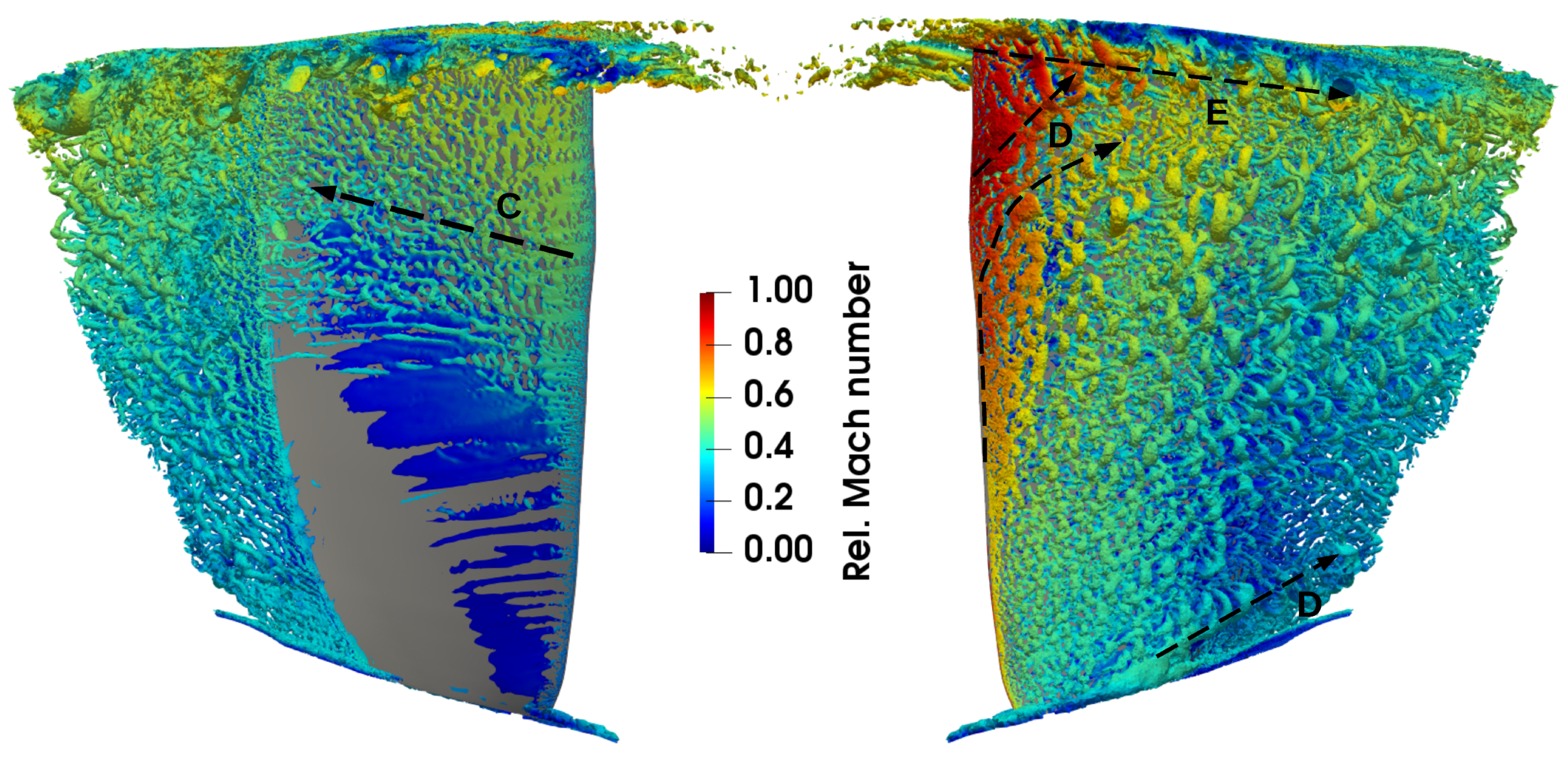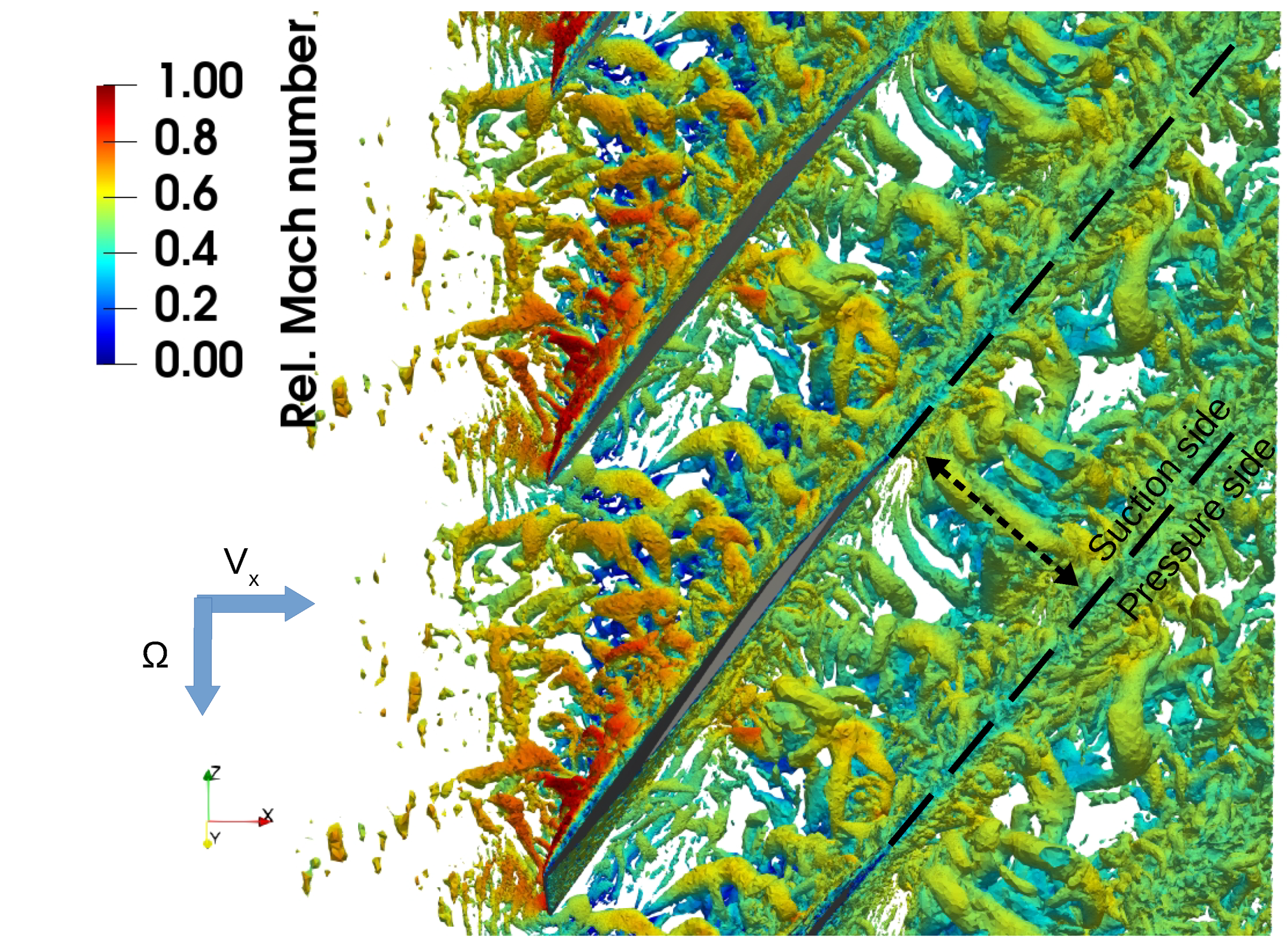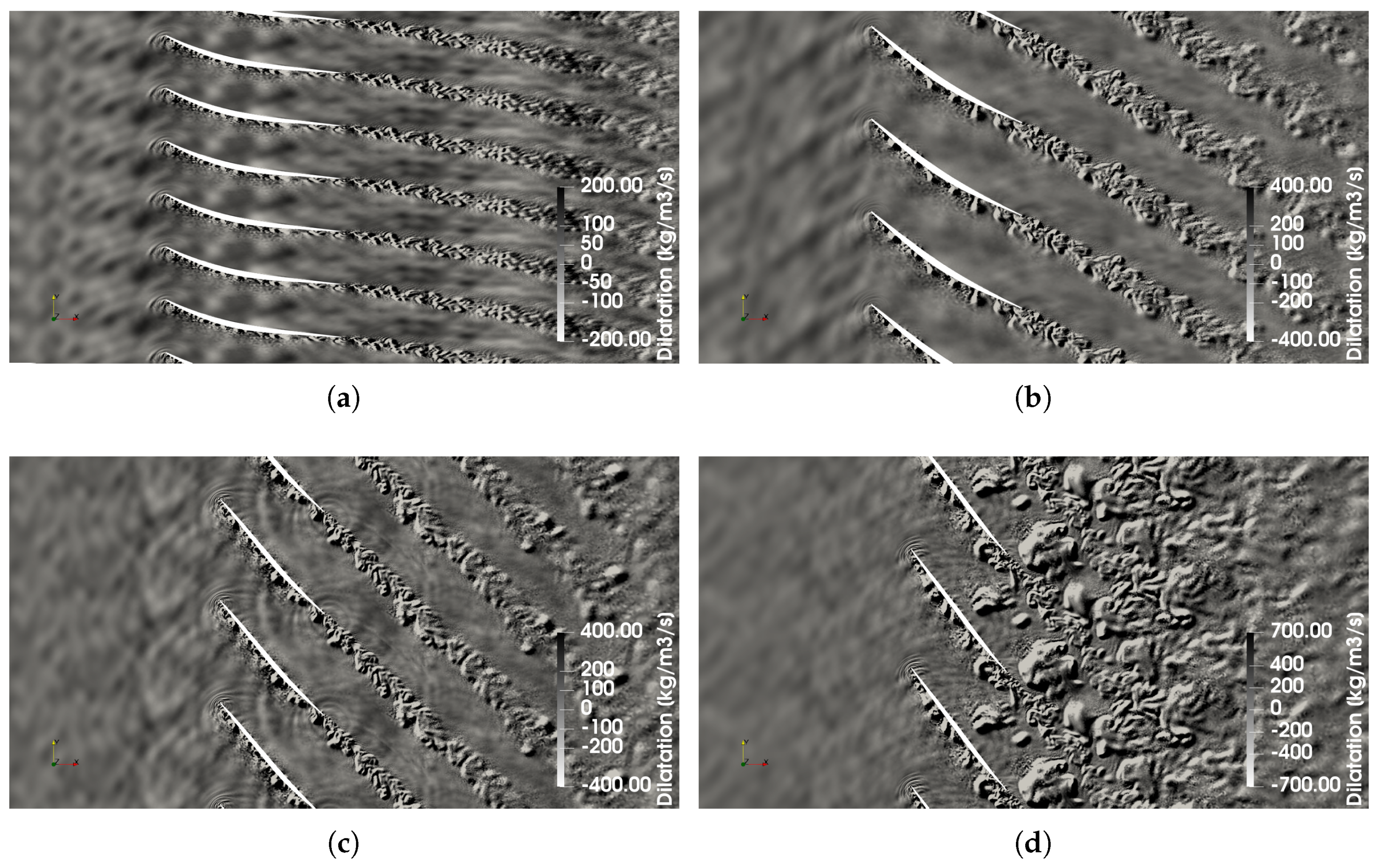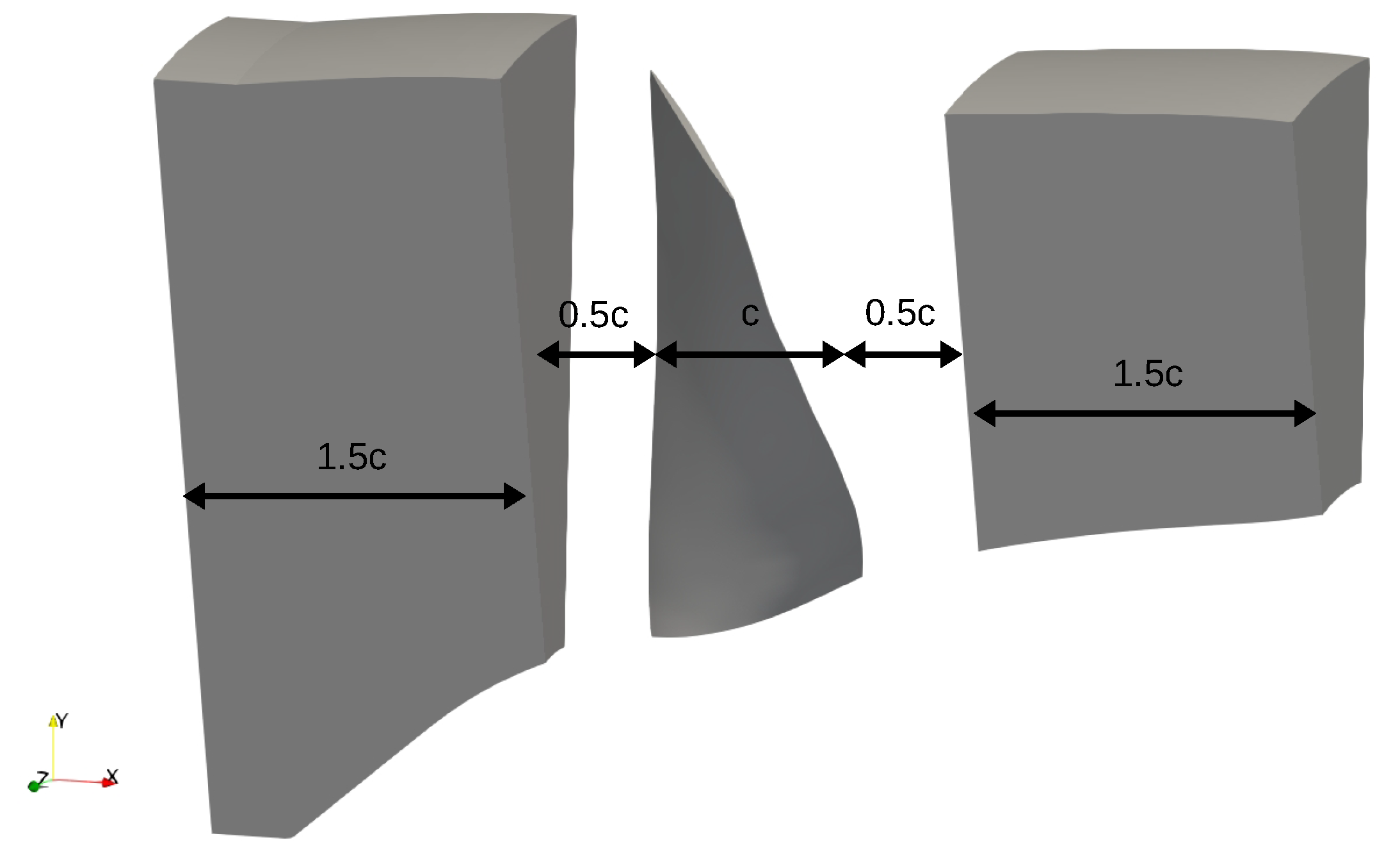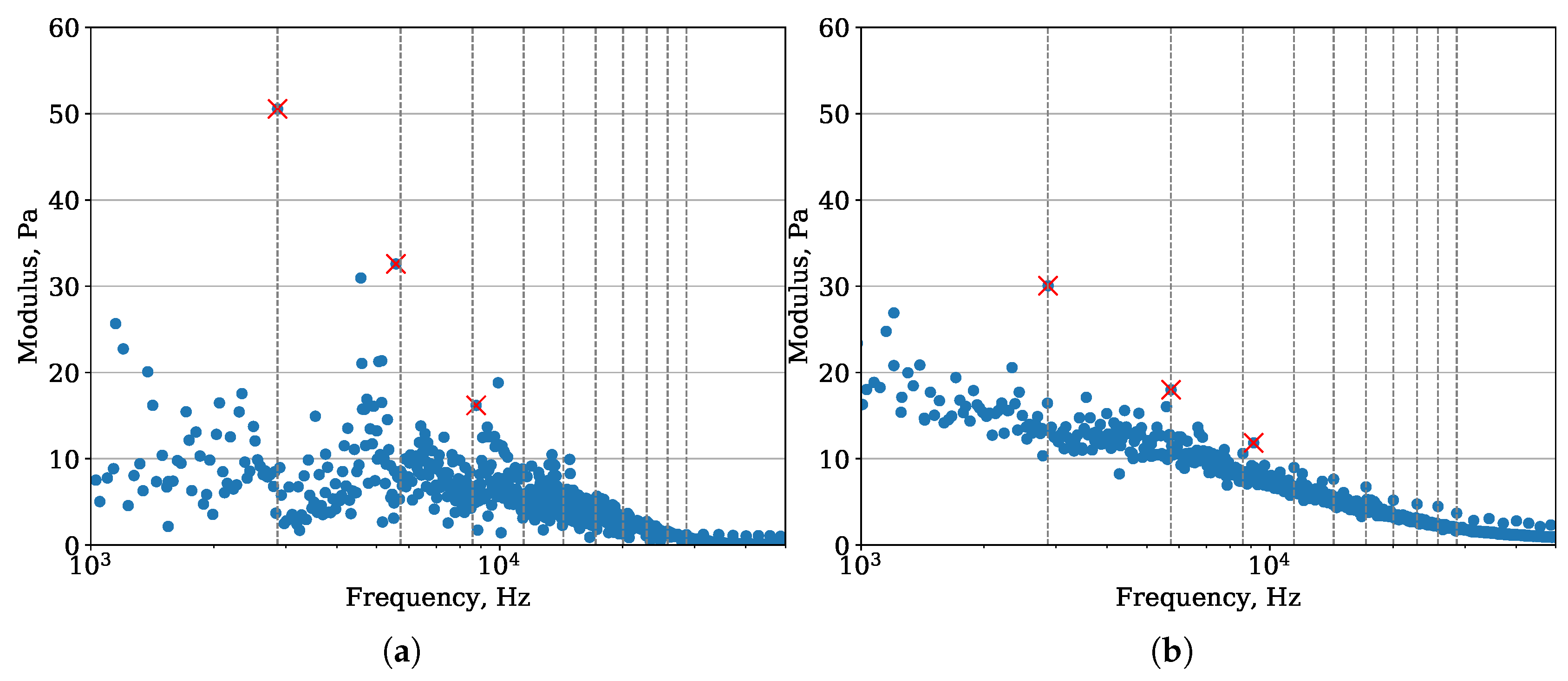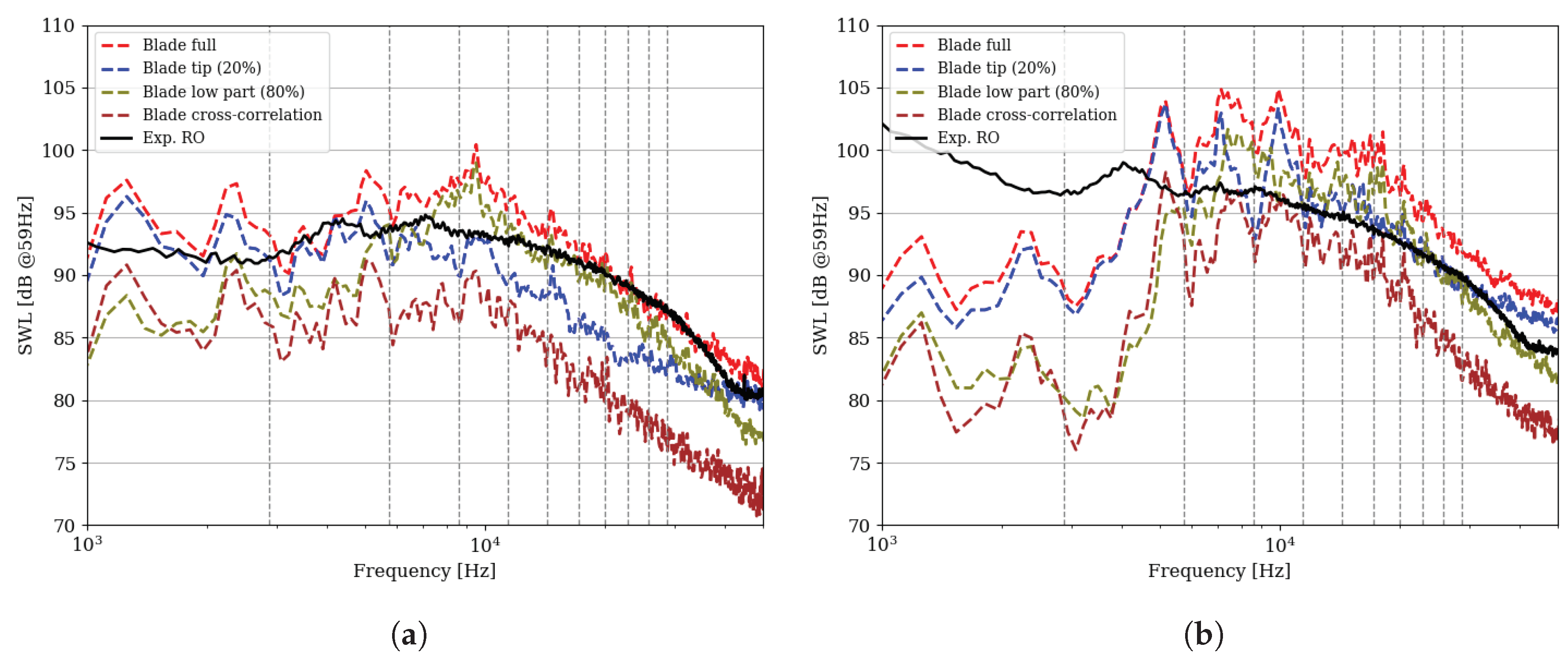3.1. Mean Flow
The comparison of the measured and computed aerodynamic performances with the experiments is shown in
Table 2. The computation shows similar performance and slight difference in the mass-flow rate compared to the experiments.
The contours of the mean velocity components at the mid-distance between the rotor and the theoretical stator location are presented in
Figure 3 for LES and the experiment. Experimental data were obtained using Hot-Wire Anemometry (HWA) [
24]. The velocities are normalized by the experimental mean axial velocity averaged in the measurement plane
m/s. The results show that the wake width is well captured in LES. However, there exists some over-prediction in the tip zone, where the flow blockage is stronger than in the experiment. In addition to that, a notable difference exists in the radial component of the mean velocity that is higher in the experiment for the wake and the inter-wake region. For the experiment and LES, the axial velocity component dominates in the flow except for the lower 40% of span where the tangential component also becomes relatively large.
More quantitative comparison is given in form of meridional profiles at the same axial position. The results are presented in
Figure 4. All the components are normalized by the same quantity as in
Figure 3. This comparison shows that, except for the radial component, there is a very good match between the computation and experimental data. For the radial velocity component, the lower values in LES indicate a better radial equilibrium condition. It may be the effect of boundary profiles obtained from RANS simulations [
17], where this condition was imposed on the outlet surface.
The relative difference between the profiles can be estimated by interpolating LES data on the experimental grid. By doing this, the obtained root mean square (RMS) of the difference between LES and the experiment is 3.6% for the axial, 6.4% for the radial and 3.7% for the tangential components. A notable difference between the computation and the experiment exists only in the region very close to the tip. There, the maximum difference reaches in the axial velocity at 96% of span. For the radial velocity it is at 5% of span. For the tangential velocity, the maximum difference is at 98% of span. These span positions are on the edge of the casing boundary layer and are probably affected by the absence of the prism layers on the casing wall in LES. Consequently, the previously stated difference in the mass-flow rate comes from stronger flow blockage in the very tip of the flow passage.
The normalized RMS contours of the velocity fluctuations are shown in
Figure 5 for the same axial position as the mean velocities. Again, there is a good match with experimental data. The RMS values in the wake are close to the experiment, and an over-prediction exists only in the tip region. There is also a spot of elevated RMS values close to the hub in LES which is possibly a trace of the corner vortex. The maximum RMS values of the axial velocity fluctuations are located in the middle of the wake, whereas the radial and tangential components have their maxima shifted to one side.
The same procedure as for the mean velocities is applied to estimate the difference between LES and the experiment. The RMS of the difference between computed and measured data is 1.5% for the axial, 1.2% for the radial and 1.7% for the tangential components. The meridional profiles shown in
Figure 6 depict a close match between 20% and 80% of span. After 80%, the difference is present for all three components. The maximum difference between the profiles is
for the axial,
for the radial and
for the tangential component. Interestingly, all three components have the same position of the maximum difference with the experiments which is 89% of span. The profiles also show a growing trend in experimental data below 10% of span that possibly corresponds to the corner vortex. The corresponding growth of all three RMS components in LES starts below 20% of span.
The results presented above show that, despite some over-prediction in the outer part of the flow passage the LES computation is quite close to the experiments. This allows studying further the mean flow field in the rest of the domain. The relative Mach number contours and the turbulence intensity at different spanwise positions are presented in
Figure 7 and
Figure 8. The flow field does not reveal any particularity at 25% of span. A leading-edge flow detachment is visible by low-Mach number and high turbulence intensity zones on the suction side at 50% of span (zone A). The detachment grows with the increase in span. The unsteady flow analysis presented below will show that it is a trace of a spanwise-moving leading-edge vortex. At 90%, the separation zone occupies one half of the suction side and is associated with the high-level zone of turbulence intensity. At this spanwise position, the leading-edge vortex rolls off towards the trailing edge and collides with the lowermost part of the tip vortices. A low-velocity and high-turbulence zone (B) is also visible in the inter-blade region. It is an averaged trace of tip vortices that are moving streamwise and inwards while being convected by the mean flow.
3.2. Unsteady Flow
The next step in the study is to investigate the unsteady flow pattern in order to reveal the flow features that can possibly serve as noise excitation mechanisms. The unsteady flow is visualized in the form of iso-surfaces of the Q-criterion in
Figure 9. The pressure side of the rotor blade does not reveal any turbulent structures up to 50% of span. Further outwards, only a few small-scale structures are visible. They are convected towards the trailing edge of the blade (C). On the suction side the flow is highly turbulent. The leading-edge vortex is moving radially outwards under the effect of centrifugal force and blade twist (D). The collision of this vortex with the tip vortices (zone E) is clearly seen in
Figure 7 and
Figure 8d (zone A). Moreover, the tip vortices plunge while moving in the streamwise direction to appear in the same figures (zone B). The other noticeable feature is the corner vortex (
Figure 9 (right), zone D) that leaves its trace below 20% of span in the mean flow of
Figure 3,
Figure 4,
Figure 5 and
Figure 6. Its outward movement explains the increased radial component of the velocity in those figures.
The view from the hub on the tip vortices highlights their evolution with the flow (
Figure 10). This view reveals the formation of large tube-like structures moving between the blades. Some of them have the transverse length scale that is almost equal to the distance between the blades (dotted arrow). These structures evolve from the zone E in
Figure 9.
The dilatation field (
) allows identifying the flow perturbations that can serve as noise excitation mechanisms. Snapshots of four blade-to-blade views (in the rotor-locked reference frame) at different span positions are given in
Figure 11. The common behavior for all presented positions is a clean flow upstream of the rotor. At 25% of span only the rotor wakes are presented as a source of flow disturbance. However, low-amplitude patterns everywhere in the inter-blade region and upstream reveal an intensive propagation of the acoustic-scale waves. The circular patterns visible around the leading edge is a diffraction of these waves. The animated dilatation field shows the dynamics of the diffraction of the acoustic waves as they leave the inter-blade region and propagate further upstream.
At 50% and 75% of span, the turbulent wakes of the rotor become wider and stronger. In-between the wakes, the flow is still as clean as upstream of the fan. The wakes mainly originate from the turbulent boundary layer on the suction side of the blade, whereas the pressure-side flow is almost quiescent at 50% and shows only small-scale perturbations at 75% of span. They likely come from the small structures in
Figure 9 (left). At 90% of span, the other source of large-scale perturbations appears in the inter-blade region, completely disturbing the flow field downstream of the rotor. This phenomenon is the trace of the tip vortices grazing along the blade surface (
Figure 9 (right), zone E).
Starting from 50% of span, there are circular wave patterns coming from the trailing edge. These acoustic waves are believed to be the source of the wave propagating upstream and visible at all span positions. They also move downstream; their reflection from the turbulent wakes and the interference between neighboring sources is clearly visible at 75%. The strength of the trailing-edge sources apparently grows with increasing spanwise location (and the local flow velocity). Nevertheless, they are hidden under the tip vortices appearing at 90% between the wakes. Still, the wave diffraction is present at this spanwise position and is expectedly stronger than at 75% of span. These vortices are likely to emit acoustic waves themselves along with the trailing-edge source. This is assessed by the modal analysis presented in the next section, and the far-field acoustics computation presented later in the paper.
3.3. Dynamic Mode Decomposition
The dynamic mode decomposition (DMD) [
25] is computed using the unsteady pressure field upstream and downstream of the rotor. Two volumes are used for the recording, each is 0.12 m length and occupies all the radial and azimuthal extents of the domain. The length of the volume is chosen to fully contain one wavelength of the acoustic wave propagating at the first blade passing frequency (BPF), 2863 Hz. The volumes are shown in
Figure 12.
A total of 4096 snapshots are used for the decomposition. The data are recorded with a sampling frequency of 75 kHz and interpolated on a regular mesh with a cell size of 0.002 m. Then, a dynamic mode decomposition [
25] is performed in the stationary reference frame for each volume using the python library Antares developed at CERFACS, France [
26]. The discrete pressure field is decomposed on an ensemble of DMD modes:
where
is a k-th snapshot value of the pressure field,
is a linear mapping operator,
is an eigenvalue,
is a DMD mode.
The angular complex frequency of the DMD mode is obtained as:
where
is the recording time step. The modal amplitude is obtained by taking a quadratic norm of the DMD mode scaled by the cell volumes to obtain physically meaningful quantities:
where
N is the number of snapshots and
is the cell volume.
As a result, the amplitude spectra are given in
Figure 13 for the upstream and downstream volumes. The spectra allow identifying the most energetic modes and segregating particular modes around the frequencies of interest. In both spectra such modes are present around the first three BPF and are highlighted by the red crosses in the figure. The most prominent are the modes at the first BPF: for the upstream volume, the difference between the mean spectrum level and this mode is more than 40 Pa. For the downstream volume, this difference is smaller and counts 15 Pa. In general, the downstream spectrum is more smooth, most probably due to the presence of the strong hydrodynamic fluctuations coming from the wakes and having the same order of magnitude, whereas the clean upstream flow exhibits mostly the acoustic waves upon the quiet environment, as seen in
Figure 11. The other notable feature of the spectra is a sub-harmonic hump slightly below the second BPF in the upstream spectrum.
The temporal reconstruction of the DMD modes is obtained from the amplitude and the phase:
where
t is the time,
is the period of the fluctuations (
),
is the amplitude and
is the phase of the DMD mode
i.
The reconstruction of the upstream volume is shown in
Figure 14. It should be noted that all the modes are moving in all three directions, the dominant being the azimuthal (the rotation direction) and the axial ones. The mode at BPF1 (2.8 kHz) originates from the upper part of the blade. The amplitude of the mode increases from 50% of span and up to the tip (zone F). This corresponds very well to the diffraction patterns visible from the same spanwise position in
Figure 11. The amplitude of the mode quickly decays; however, the mode is not evanescent as it continues to propagate farther upstream with a smaller amplitude. Close to the hub, where the annular duct swiftly changes to the cylindrical one (zone G), the amplitude suddenly increases, which is the evidence of the mode matching between these two duct shapes. The inclination of the wave front suggests that even at low spanwise locations the waves come from the tip region.
The second mode, located almost exactly at BPF2 (5.7 kHz), shows different pattern. It is also the strongest at the tip, where it contains two lobes (zones H and I): the first one coming from around 75–80% of span and the second one located directly at the tip. When combined with the plots of the dilatation and the Q-criterion this mode can be assumed to originate from the roll-off of the leading-edge vortex (zone D in
Figure 9) and the tip vortices (zone B in
Figure 8, zone E in
Figure 9). At lower blade height, the inclination of the wave front is almost the same as in the mode at BPF1. This shows that the tip region is still a dominant source of acoustic waves at this frequency. The third upstream mode analyzed in the paper lies at 8.5 kHz (BPF3). Its maximum of amplitude still resides at the tip. Nevertheless, the acoustic wave propagates at a larger angle with respect to the fan axis. It exhibits an increased role of the other noise source at this frequency such as the trailing-edge noise. Other than that, the character of this mode is similar to the previously described ones.
A similar analysis is applied to the modes in the downstream volume which are shown in
Figure 15. Here, the first considered mode at 2.8 kHz is dominated by the fan wakes. At this frequency the hydrodynamic perturbations are masking the acoustic pressure field, and for most of the span the acoustic patterns are hardly distinguishable. However, below 30% height, the wakes become weaker and more axially aligned, and the temporal reconstruction shows almost axial propagation near the stationary part of the hub (zone J). It is obviously linked to the lower stagger angle of the fan blades and the smaller rotational speed. The second mode at 5.7 kHz (BPF2) shows larger amplitudes in the tip region (above 90% of span). It is coherent with the upstream mode at the same frequency (
Figure 14b) that also has a high amplitude in the same spanwise region.
The third downstream mode propagates at 9.1 kHz which is higher than BPF3 (8.5 kHz). It is only a couple of Pa higher than the mean level of the DMD modes at this frequency. However, this mode is interesting to consider because of its complex propagation behavior. In the outer half of the flow passage the mode propagates similarly to the modes at BPF1 and BPF2. Below 50%, the axial propagation direction changes and the animated reconstruction reveals that the waves move upstream. Finally, very close to the hub, similar to the modes at BPF1 and BPF2, the propagation direction again changes to downstream. The upstream propagation of the mode at span below 50% matches well with the same observation made upon the dilatation field.
Making preliminary conclusions, the modal analysis shows that, in the low and mid-frequency range, most of the acoustic fluctuations come from the tip region of the blade. It is particularly visible in the upstream volume, where the flow is not contaminated by the hydrodynamic fluctuations. For higher frequencies, the trailing-edge noise starts to make its contribution to the noise propagation as well. The following section assesses how this near-field analysis corresponds to the far-field acoustics prediction.
